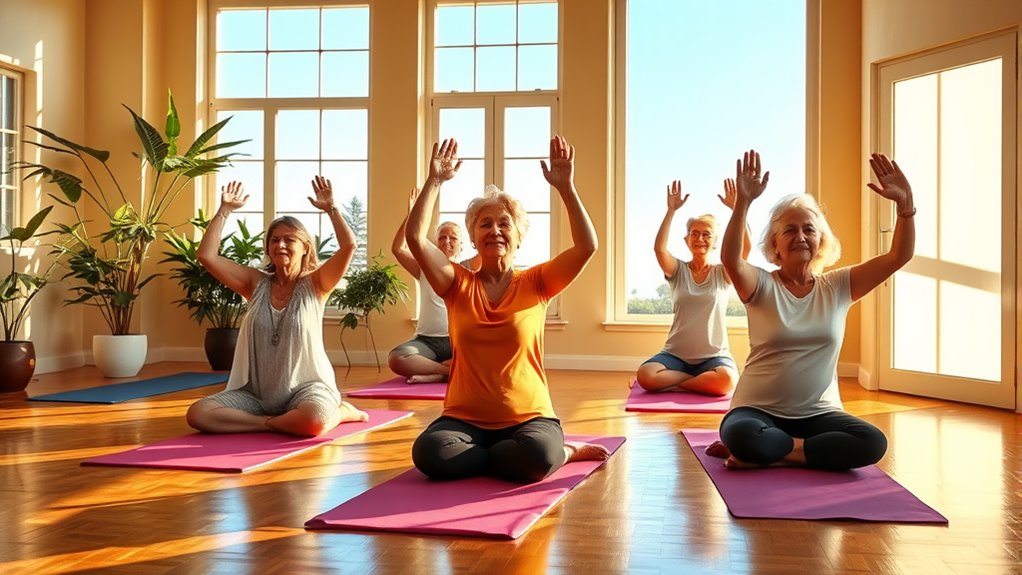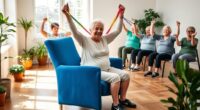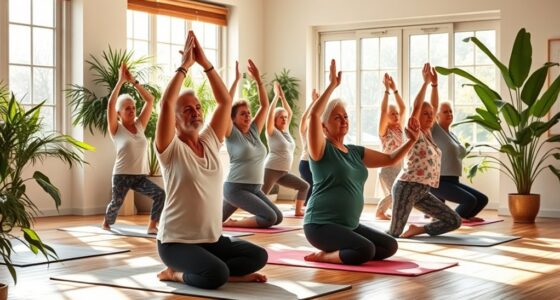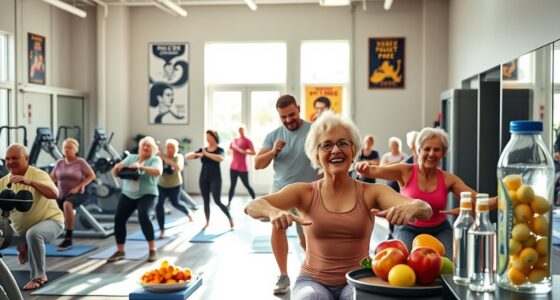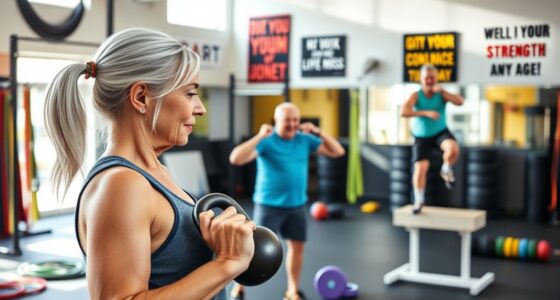The 28 Day Yoga for Seniors program guides you through mindful movement and gentle stretches that enhance your physical and mental well-being. You’ll build strength, stability, and flexibility while cultivating emotional resilience. Each day introduces new poses and practices, including core strengthening and Sun Salutations, that fit your pace. You’ll also explore mindfulness and community connections. As you celebrate your progress, you’ll find ways to integrate yoga into daily life for lasting health benefits. There’s so much more to discover!
Key Takeaways
- Embrace gentle stretches and foundational poses, such as Mountain Pose and Ragdoll, to enhance flexibility and mobility in seniors.
- Incorporate mindful movement and breathing exercises to reduce stress, improve mental clarity, and promote emotional well-being throughout the month.
- Focus on building strength and stability with poses like Warrior II and Triangle Pose to enhance balance and prevent falls among seniors.
- Prioritize alignment techniques to ensure safety during practice, preventing injuries and enhancing the effectiveness of yoga poses.
- Foster community connections through group yoga classes, promoting emotional well-being and enhancing social ties among seniors.
Day 1: Embracing Mindful Movement
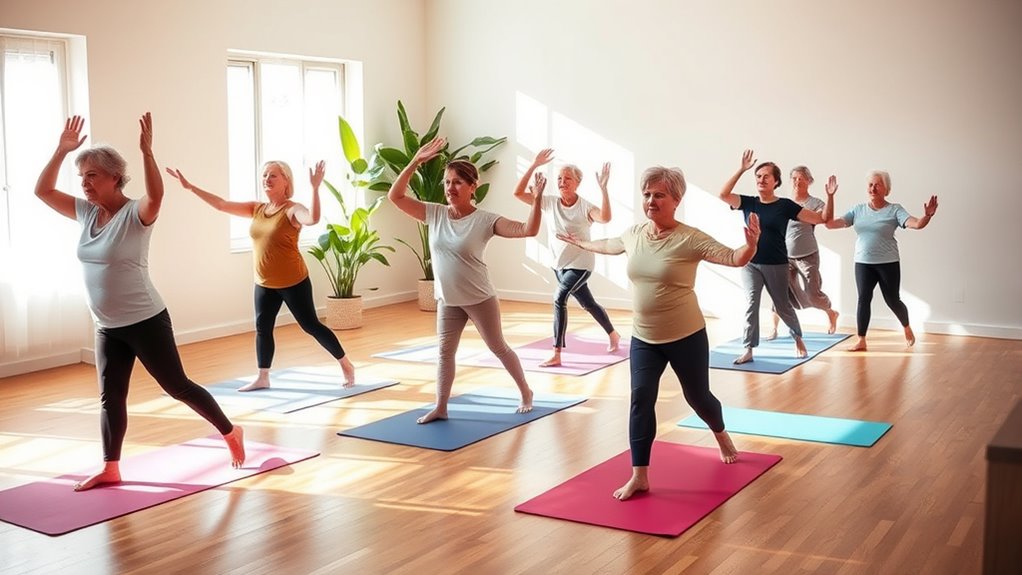
As you begin Day 1 of the “28 Day Yoga for Seniors” program, you’ll embrace mindful movement through gentle stretches and poses designed to enhance your flexibility and mobility.
You can look forward to foundational poses like Mountain Pose and Ragdoll, which promote proper posture while releasing tension in your back and shoulders. Incorporating leafy greens into your diet can further support your cognitive function, complementing your yoga practice. Engaging in mindful movement can also foster emotional and psychological growth, enhancing your overall well-being as you progress. Additionally, the recent trend of new Bitcoin holders controlling significant supply highlights the importance of adaptability in an evolving landscape. Practicing mindfulness can significantly improve your stress management skills, further enhancing your yoga experience.
As you practice Sun Salutations and Warrior sequences, you’ll find it easier to build strength and balance, essential for stability and joint health.
Seated poses like Staff Pose and Easy Pose will encourage relaxation and mindful breathing.
Seated poses like Staff Pose and Easy Pose foster relaxation and mindfulness, enhancing your breathing and overall well-being.
Finally, the Butterfly Pose helps promote hip flexibility and comfort, allowing you to engage in gentle movements that enhance your overall physical well-being throughout this enriching journey. Additionally, practicing yoga can create a sense of calm and clarity that contributes to emotional well-being, enhancing your experience as you progress through the program.
Day 2: Gentle Warm-Up and Stretches
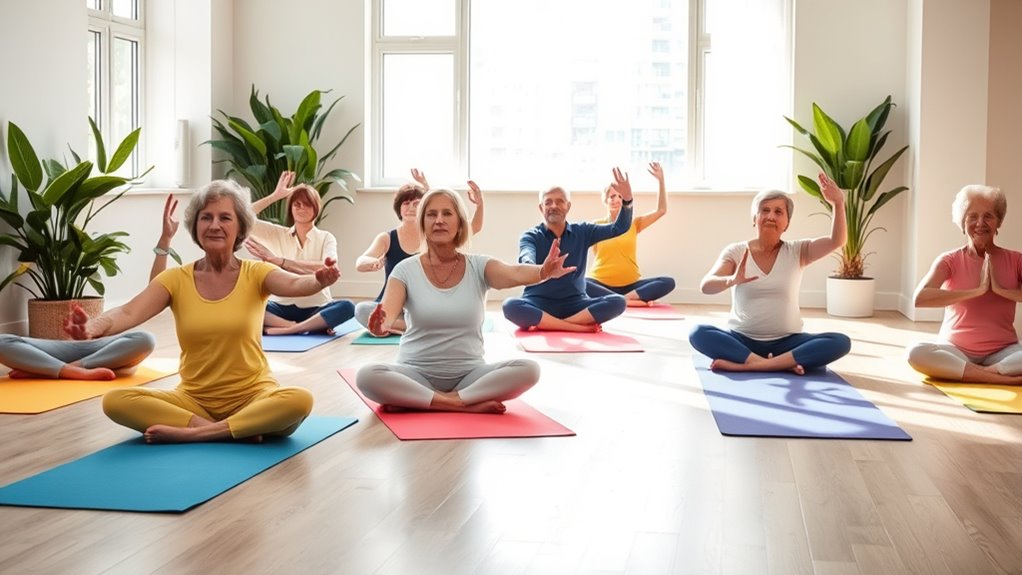
On Day 2, you’ll kick off your session with Mountain Pose to establish proper posture, setting a solid foundation for your practice.
Next, gently bend forward to stretch the back of your legs, preparing your body for movement. Incorporating essential oils such as peppermint oil can also help refresh your mind and enhance your focus during these stretches. Many essential oils can improve indoor air quality, making your practice space more inviting. Maintaining skin hydration is equally important to feel comfortable during your practice.
Incorporate Ragdoll by bending your knees and grabbing your elbows, allowing for a soothing release of tension in your back and shoulders.
Shift into shoulder rolls and stretches to boost mobility and ease stiffness.
Engage in a Sun Salutation sequence, featuring gentle back bends, lunges, and Downward Dog to warm up your entire body.
Finally, settle into seated poses like Easy Pose and Butterfly Pose, focusing on deep hip stretches and relaxation techniques to enhance comfort and mobility. This practice can also help you align with your desired realities through the subconscious power that yoga can cultivate during relaxation.
Day 3: Building Balance and Stability
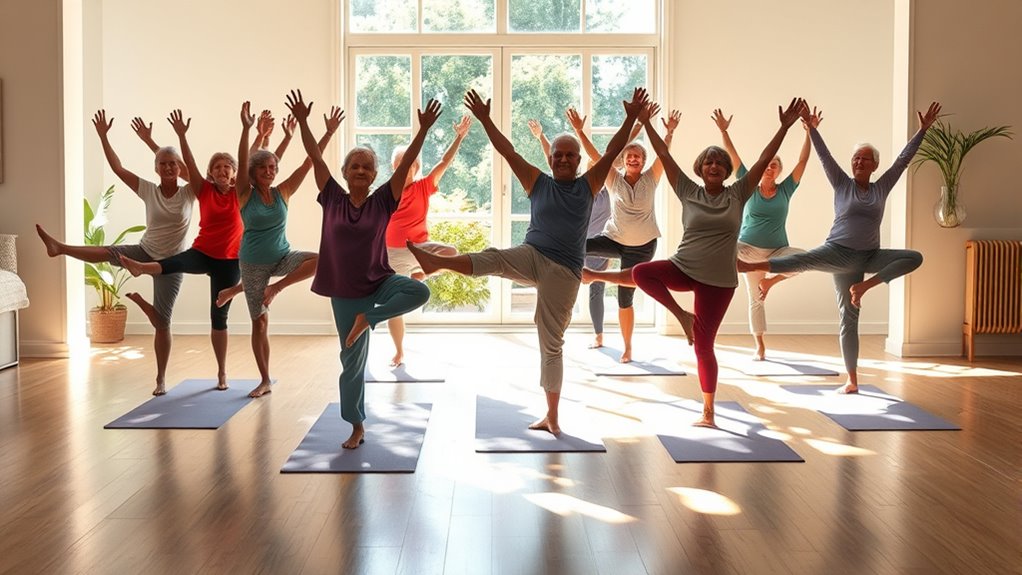
After warming up and stretching, it’s time to focus on building balance and stability, key components for maintaining independence as you age.
Today, you’ll practice poses like Warrior II and Triangle Pose. These not only enhance your physical balance but also sharpen your mental focus and body awareness, which are vital for overall stability. Individuals with BPD traits may particularly benefit from these practices as they can improve emotional regulation and mindfulness. Engaging in activities that promote cognitive growth can further support your balance and coordination efforts. Additionally, incorporating quality assurance practices into your daily routine can help ensure consistent progress in your physical activities. Socialization with others during these exercises can further enhance your experience and build a sense of community support.
Incorporating simple movements, such as shoulder rolls and body swings, will relieve tension while promoting better coordination. Regular practice of these balance-focused routines strengthens your core and improves proprioception, greatly reducing the risk of falls. Additionally, maintaining consistent routines can provide a sense of stability that is crucial for overall well-being.
As you gain confidence in your mobility, you’ll feel encouraged to stay active and engaged in your daily life, making balance training an essential part of your routine.
Day 4: Introduction to Sun Salutations

Sun Salutations, or Surya Namaskar, offer a gentle yet effective way to enhance your flexibility, strength, and balance.
This flowing sequence consists of at least 12 distinct movements that engage various muscle groups while improving circulation and respiratory function. As you practice Sun Salutations regularly, you may notice increased joint mobility and reduced stiffness, making it especially beneficial if you’re less active. Incorporating essential oils into your practice can enhance relaxation and improve your overall experience. Regular use of essential oils for hair growth can also stimulate hair follicles, promoting overall wellness as part of your daily routine. Additionally, practicing gentle stretching before your yoga session can help relax your muscles and prepare your body for movement. Engaging in regular physical activity, like yoga, can also contribute to reducing stress levels, which is vital for overall health and well-being. Creating a supportive home environment for practicing yoga can further enhance your experience and motivation.
Each sequence encourages mindfulness and breathing awareness, helping to reduce stress and promote relaxation—key elements for your mental well-being. You can easily adapt these poses to fit your individual fitness level, ensuring you enjoy the benefits safely and effectively. Incorporating Sun Salutations into your daily routine can be a rewarding step towards a healthier you.
Day 5: Strengthening the Core
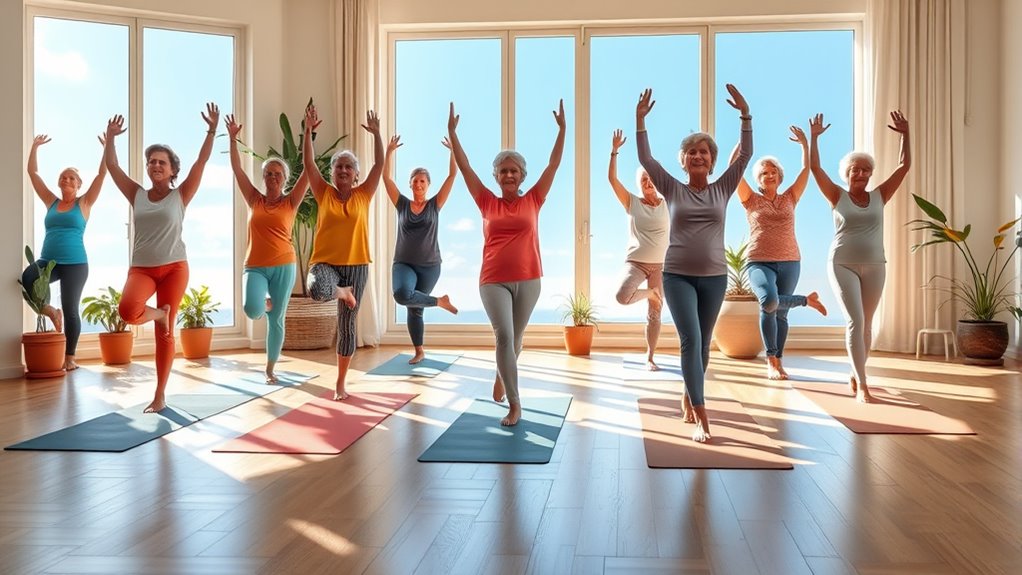
Strengthening your core is essential for enhancing balance and stability, which helps prevent falls and supports your independence in daily activities. Engaging in core-strengthening exercises can also improve your posture, reducing back pain and boosting spinal health. You can incorporate simple exercises like seated leg lifts, modified planks, and gentle twists to effectively target your core muscles without straining your body. Additionally, these exercises can help cultivate resilience as you gradually increase your strength and endurance. Maintaining color accuracy in your physical environment, such as ensuring good lighting, can further enhance your exercise experience and motivation. Including various yoga styles in your routine can also provide a holistic approach to strengthening your core. Furthermore, practicing emotional alignment can enhance your focus and intention during workouts, leading to more fulfilling exercise sessions.
These consistent workouts will increase your functional strength, making it easier to stand up from a chair or walk. Additionally, pairing breathing techniques with these exercises enhances relaxation and mindfulness, contributing to your overall mental well-being. Remember, strong communication skills during exercise can also boost motivation and accountability in your routines. Dedicate today to core strengthening, and feel the benefits in both your body and mind.
Day 6: Exploring Warrior Poses
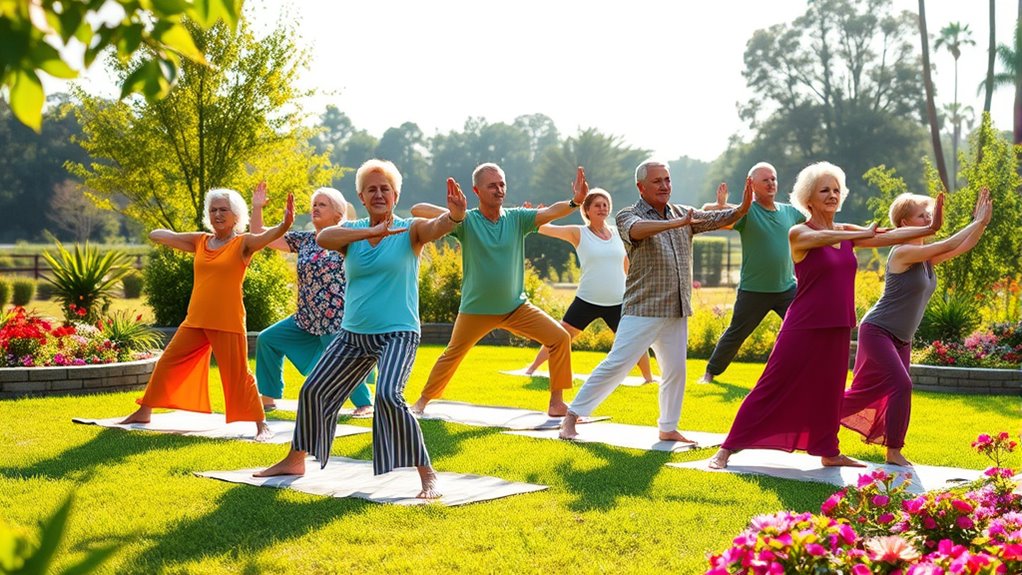
Today, you’ll explore the powerful Warrior Poses that can boost your strength, stability, and balance.
As you practice, pay close attention to your alignment, especially in Warrior II, to protect your joints.
These poses not only enhance your physical health but also sharpen your mental focus and flexibility.
Benefits of Warrior Poses
Warrior poses, including Warrior I, II, and III, offer numerous benefits that are especially valuable for seniors.
These poses enhance lower body strength and stability, which are essential for maintaining balance and preventing falls. You’ll also notice improved hip flexibility and better posture, contributing to reduced back pain.
Practicing Warrior poses can help you cultivate mental focus and concentration, boosting your cognitive function and mindfulness. The deep breathing involved encourages lung capacity and promotes relaxation, helping to lower stress and anxiety levels.
By engaging in these poses regularly, you’ll increase your endurance and energy, enabling you to maintain an active lifestyle and enhance your overall quality of life.
Embrace the power of Warrior poses for a healthier you!
Correct Alignment Techniques
Correct alignment is essential when practicing Warrior poses to guarantee safety and effectiveness, especially for seniors.
In Warrior II, make sure your front knee is directly over your ankle to avoid strain and enhance balance. Extend your arms parallel to the ground, keeping your shoulders relaxed.
When shifting to Reverse Warrior, engage your hips and keep your back leg straight while maintaining an open chest and lifted gaze. This alignment promotes a deep stretch and strengthens your legs, improving flexibility and mobility.
If you need extra support, don’t hesitate to use a wall or a chair. These modifications help make Warrior Poses more accessible, allowing you to practice safely and confidently.
Day 7: Cultivating Inner Peace

As you move through Day 7 of your yoga journey, you’ll discover that cultivating inner peace is fundamental for enhancing your overall well-being.
Mindfulness practices in yoga help reduce stress and anxiety, which are essential for improving mental health. Focus on deep diaphragmatic breathing during your sessions to promote relaxation and calm.
Incorporate gentle stretches, like Easy Pose and Butterfly Pose, to not only improve flexibility but also encourage a meditative state, connecting you to your inner self.
Regular practice increases self-awareness, allowing you to better understand your emotions and foster a peaceful mindset.
You’ll also find that a consistent yoga routine can enhance your sleep quality, critical for maintaining tranquility and overall mental health.
Day 8: Seated Poses for Flexibility

Day 8 is all about seated poses that enhance flexibility, essential for maintaining mobility as you age.
Start with Staff Pose to align your spine and engage your core. Shifting into Easy Pose can further open your hips while improving posture.
Try Seated Ragdoll next; bend forward and let your head hang to deepen the stretch in your back and legs, promoting relaxation. Incorporate deep breathing throughout your practice to help release tension and increase flexibility.
Moving from Easy Pose to Butterfly Pose also encourages gentle hip opening.
Regularly practicing these seated poses boosts blood circulation and overall joint health, paving the way for a more active and independent lifestyle.
Enjoy these benefits as you embrace greater flexibility today!
Day 9: Deepening Hip Openers

While deepening your hip openers, you’ll find that enhancing flexibility and mobility is crucial for preventing falls and injuries as you age.
Incorporating poses like Butterfly and Easy Pose allows for gradual stretching of your hip joints, making it suitable for your fitness level. These hip-opening stretches not only alleviate discomfort and tension in your lower back but also improve your overall posture.
Regular practice supports better circulation, contributing to increased energy levels throughout your day. As you focus on breath and alignment during these stretches, you promote mindfulness and relaxation, essential for your overall well-being.
Embrace this opportunity to nurture your hips and enjoy the benefits of greater movement and stability in your daily life.
Day 10: Connecting Breath With Movement
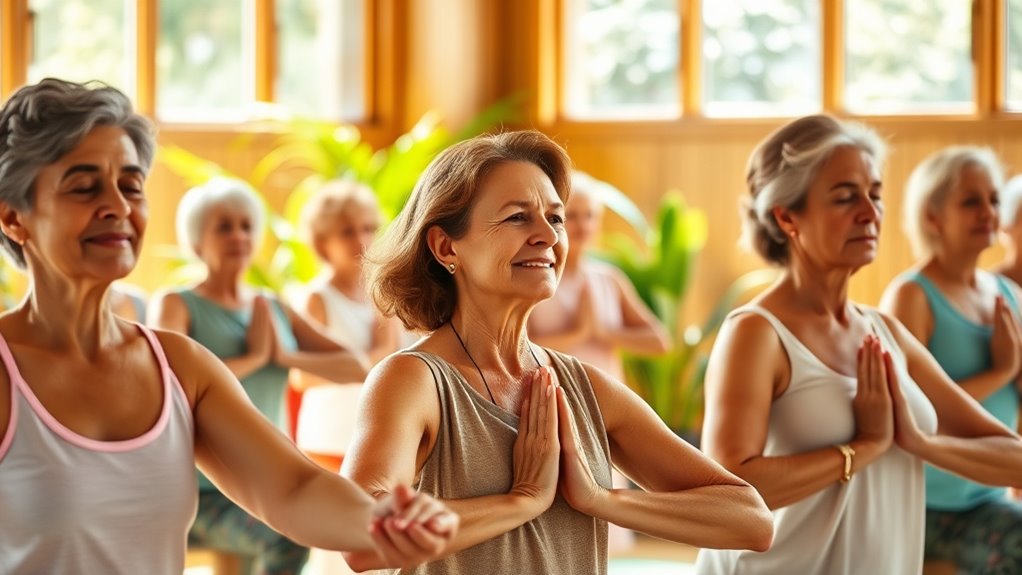
Building on the foundation of hip openers, connecting breath with movement enhances your yoga practice by fostering mindfulness and deeper body awareness. By coordinating your breath with your movements, like inhaling during upward motions and exhaling while lowering, you improve oxygen flow and stamina. Diaphragmatic breathing during stretches helps alleviate tension and supports cardiovascular health. As you practice breath awareness in sequences such as Sun Salutations or Warrior poses, you’ll notice improved balance and stability, reducing fall risks. This focus on breath encourages calmness and mental clarity, contributing positively to your overall well-being.
| Breath Movement | Benefits | Poses to Practice |
|---|---|---|
| Inhale during lift | Increases oxygen flow | Upward Dog, Warrior I |
| Exhale during lower | Promotes relaxation | Forward Fold, Child’s Pose |
| Diaphragmatic breathing | Improves flexibility | Seated Forward Bend |
| Breath awareness | Enhances balance and stability | Sun Salutations |
Day 11: Developing Upper Body Strength

Today, you’ll focus on developing upper body strength, which is essential for everyday tasks and maintaining good posture.
You’ll explore effective stretching techniques to enhance shoulder mobility and practice poses that build strength in your arms and back.
Importance of Shoulder Mobility
Shoulder mobility is essential for maintaining your upper body strength and preventing injuries, especially as you age. Engaging in regular shoulder mobility exercises not only improves flexibility and range of motion but also enhances daily activities like reaching and lifting. Here’s a quick overview of the benefits:
| Benefit | Description | Impact on Daily Life |
|---|---|---|
| Improved Flexibility | Increases range of motion | Easier to reach overhead |
| Reduced Tension | Alleviates discomfort in shoulders | Better posture |
| Enhanced Blood Circulation | Boosts muscle activation | Increased endurance |
| Greater Strength | Supports overall upper body function | Helps with lifting tasks |
| Increased Independence | Promotes autonomy in daily activities | Maintains quality of life |
Incorporate these movements into your routine for a healthier you!
Effective Stretching Techniques
Maintaining shoulder mobility sets the stage for effective stretching techniques that can greatly enhance your upper body strength.
By focusing on flexibility and range of motion, you can improve your daily activities and overall mobility. Incorporate these techniques into your routine:
- Shoulder rolls to release tension and improve posture
- Arm stretches to enhance flexibility and strength
- Seated Ragdoll for safe, deep stretching without straining your back
- Warrior II and Triangle Pose to build stability and balance
Regularly practicing these stretches will lead to better muscle tone and endurance, contributing to a healthier, more active lifestyle.
As you progress, you’ll notice increased upper body strength that supports your everyday movements.
Strengthening Through Poses
As you progress in your yoga journey, developing upper body strength becomes essential for enhancing your daily activities and overall well-being. Poses like Downward Dog and Warrior II engage multiple muscle groups, improving your stability and strength.
Incorporating shoulder rolls and arm stretches into your routine boosts shoulder mobility and reduces tension, crucial for upper body strength. Seated poses such as Staff Pose and Easy Pose not only promote proper posture but also strengthen your arms, shoulders, and back.
Adding gentle back bends during Sun Salutations can enhance your flexibility and alignment while strengthening the upper back. With consistent practice, you’ll notice increased muscle tone and functional strength, making daily tasks much easier.
Day 12: Finding Comfort in Easy Pose

Finding comfort in Easy Pose can transform your yoga practice, especially on Day 12 of your journey. This foundational seated position not only promotes relaxation but also enhances flexibility and balance.
Embrace Easy Pose to enhance relaxation, flexibility, and balance on your yoga journey.
To enter Easy Pose, sit cross-legged with flexed feet, ensuring your spine is comfortably aligned.
As you breathe, consider these elements to deepen your experience:
- Inhale and raise your hands, expanding your chest.
- Exhale and lean gently forward, deepening the hip stretch.
- Use a folded blanket or cushion under your hips for extra support.
- Feel the calming effects as your circulation improves and tension in your lower back reduces.
Embrace this moment of mindfulness, and enjoy the tranquility that Easy Pose brings.
Day 13: Relaxation Techniques for Seniors

On Day 13, you’ll explore effective relaxation techniques tailored for seniors that can greatly enhance your well-being.
Start with deep breathing exercises, like diaphragmatic breathing, to improve lung capacity and increase oxygen intake.
Next, try progressive muscle relaxation; tense and then relax different muscle groups to alleviate physical tension and promote better sleep.
Mindfulness meditation is another great tool—focus on the present moment to cultivate awareness and combat feelings of loneliness or depression.
Finally, incorporate gentle yoga practices, including restorative poses and stretches, to enhance relaxation and flexibility.
These techniques not only reduce stress and anxiety but also notably improve your overall quality of life, making each day more enjoyable and fulfilling.
Day 14: Engaging in Mindful Meditation
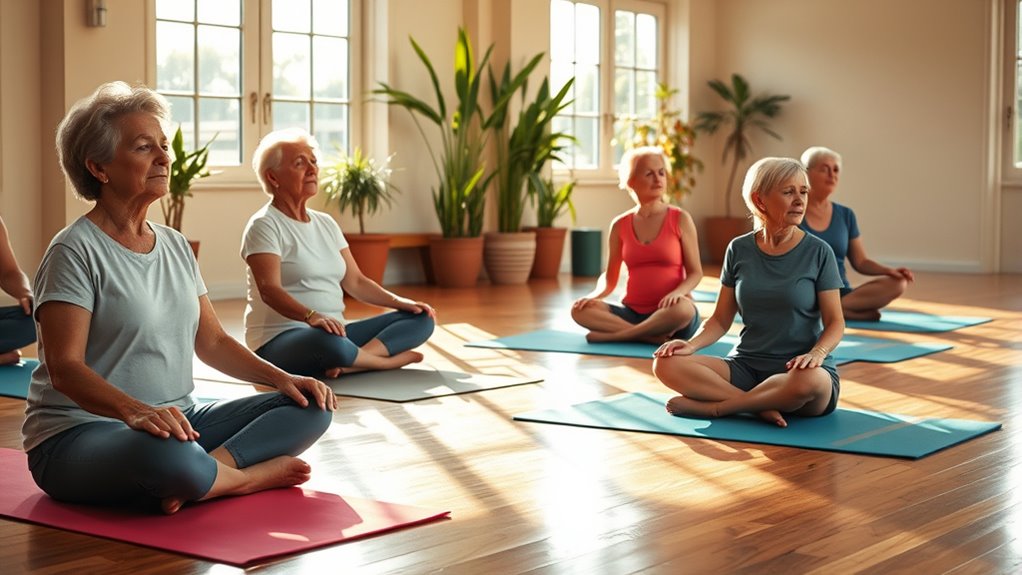
On Day 14, you’ll explore the importance of mindfulness and how it can transform your meditation practice.
By using simple techniques, you can enhance your ability to focus and connect with your inner self.
Let’s discover how mindful meditation can improve both your mental and physical well-being.
Importance of Mindfulness
While life’s challenges can often feel overwhelming, engaging in mindful meditation offers seniors a powerful tool for enhancing mental well-being. By dedicating just 10-15 minutes daily, you can experience remarkable benefits, including:
- Reduced stress and anxiety, promoting a calmer mind.
- Improved focus and attention, countering cognitive decline.
- Enhanced sleep quality, leading to better overall health.
- Greater body awareness and acceptance, fostering a positive relationship with your physical abilities.
Mindfulness practices encourage resilience and strengthen coping strategies, enabling you to navigate the complexities of aging more effectively.
By incorporating mindful meditation into your routine, you’re not just investing in your mental health today; you’re building a foundation for a more fulfilling tomorrow.
Embrace this journey towards improved well-being!
Techniques for Meditation
Engaging in mindful meditation can transform your daily routine, providing a pathway to greater peace and clarity. By focusing on the present moment, you observe your thoughts, feelings, and sensations without judgment.
This practice enhances your mental well-being and reduces stress. Just 10 minutes a day can considerably alleviate symptoms of anxiety and depression, offering a natural alternative to medication.
Incorporate mindful breathing techniques, like deep inhalations and prolonged exhalations, to calm your nervous system and promote relaxation. Establishing a consistent routine fosters emotional resilience and improves your overall quality of life.
As you practice, you may notice up to a 30% increase in focus, helping you navigate daily challenges with greater ease.
Day 15: Enhancing Posture Awareness

Good posture is essential for maintaining your health and mobility as you age, since it helps prevent back pain and enhances overall body alignment.
Good posture is vital for health and mobility as you age, preventing back pain and improving body alignment.
Today, focus on enhancing your posture awareness through simple yoga practices. Consider these activities:
- Mountain Pose: Stand tall, grounding your feet, and lengthen your spine.
- Seated Stretches: Gently reach for your toes to release tension in your back.
- Shoulder Rolls: Rotate your shoulders to alleviate tightness and promote relaxation.
- Warrior II and Triangle Pose: Focus on spinal alignment, helping you recognize and correct poor posture habits.
Day 16: Gentle Flow for Stress Relief
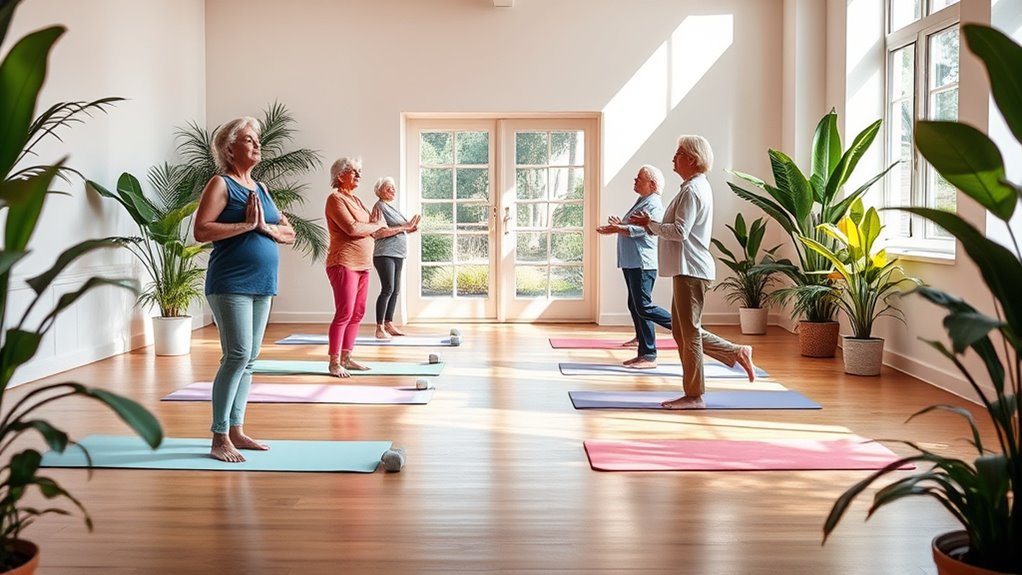
On Day 16, you’ll explore relaxation techniques that help melt away stress and tension.
As you practice mindful movements and breathing exercises, you’ll discover how they can enhance your overall sense of well-being.
Embracing mindfulness in your flow not only calms your mind but also connects you deeper to your body.
Relaxation Techniques Overview
As you explore the Gentle Flow for Stress Relief, you’ll discover how slow, mindful movements can greatly enhance relaxation and alleviate tension in your body.
This sequence emphasizes deep breathing, activating your parasympathetic nervous system to foster calmness and reduce stress.
Imagine the soothing effects of:
- Mountain Pose: grounding you, connecting you to the earth.
- Easy Pose: inviting comfort and stillness.
- Butterfly Pose: gently opening your hips to release tightness.
- Shoulder Rolls: melting away tension, allowing freedom in your upper body.
Breathing Exercises Benefits
While you flow through your yoga practice, integrating breathing exercises can profoundly enhance your stress relief journey.
These techniques activate your body’s relaxation response, lowering cortisol levels and promoting calm. By focusing on deep, diaphragmatic breathing, you improve oxygen flow to your brain and body, which boosts mental clarity and eases anxiety.
Regularly practicing these controlled breathing methods can help lower blood pressure and enhance heart rate variability, benefiting your cardiovascular health. Engaging in mindful breathing during your sessions increases your awareness and presence, making it easier to manage stress in daily life.
Plus, studies show that incorporating breathing exercises into your routine can lead to better sleep quality, further supporting your overall health and well-being.
Mindfulness in Movement
Mindfulness in movement encourages you to connect your breath with gentle, intentional movements, creating a calming practice that reduces stress.
As you flow through your routine, focus on the sensations in your body.
Consider incorporating the following:
- Shoulder rolls to release tension and increase mobility.
- Gentle stretches that ease tightness in the upper body.
- Seated poses like Easy Pose and Staff Pose, helping you find alignment and grounding.
- Flowing sequences moving through Warrior and Triangle Poses, promoting strength and flexibility.
Day 17: Understanding the Importance of Alignment
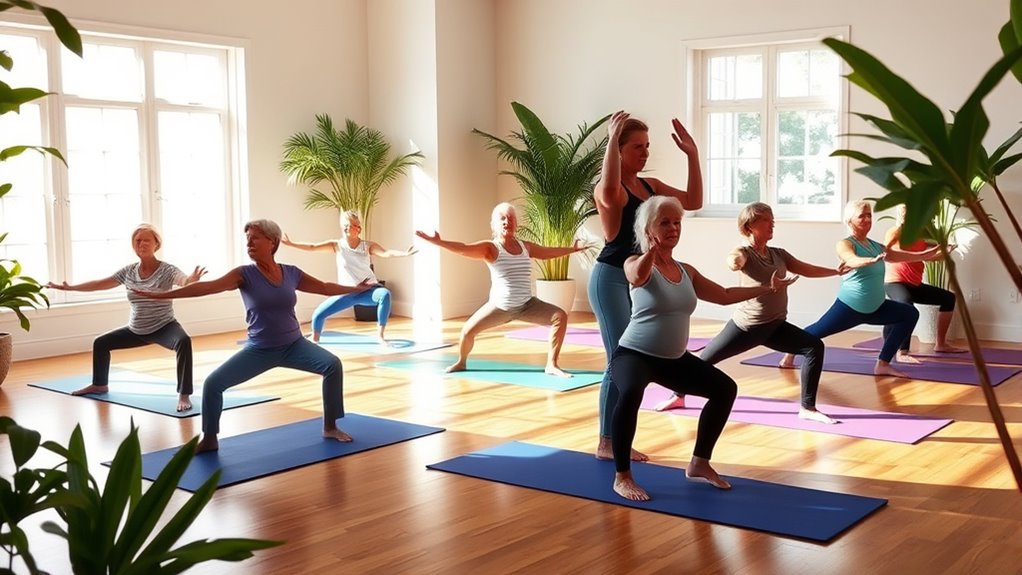
Understanding proper alignment in yoga is essential for maintaining safety and maximizing the benefits of your practice, especially as you age. Proper alignment prevents injuries by ensuring your joints and muscles engage correctly during poses, reducing strain on ligaments and tendons.
It also enhances the effectiveness of each pose, allowing for deeper stretches and better muscle engagement, which is crucial for improving your flexibility and strength. Focus on key alignment principles: keep your spine straight and neutral, align your knees over your ankles, and maintain shoulder stability to promote overall balance.
Day 18: Exploring Butterfly Pose
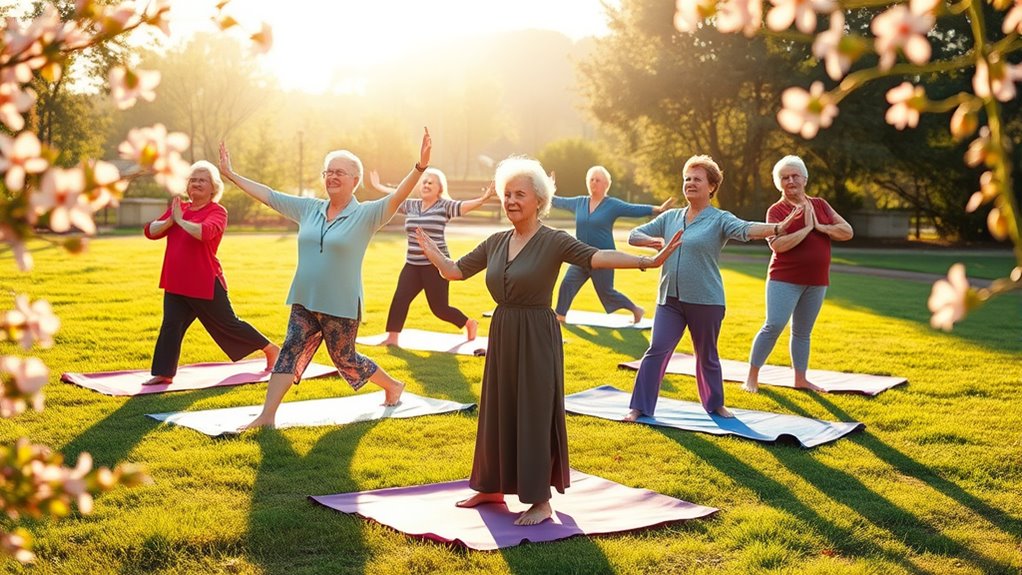
As you explore Butterfly Pose, or Baddha Konasana, you’ll discover an effective way to enhance hip flexibility and mobility, which is especially beneficial for seniors.
This pose not only opens your hips but also promotes relaxation and circulation.
Here’s how to get started:
- Sit comfortably with your feet together, letting your knees gently drop to the sides.
- Keep your back straight while allowing your knees to bounce lightly for a soothing stretch.
- Feel the gentle release of tension in your lower back as you breathe deeply.
- Take just a few minutes daily to notice the increased range of motion in your hips.
Incorporating Butterfly Pose into your routine can greatly improve your balance and stability, making daily activities easier and more enjoyable.
Day 19: Invigorating the Spine

Day 19 is all about invigorating your spine, and it’s essential for maintaining flexibility and mobility as you age.
You’ll begin with gentle stretches like Cat-Cow and Seated Ragdoll, which stimulate spinal fluid circulation. These poses not only enhance spinal health but also reduce stiffness.
Incorporating regular spinal exercises can alleviate back pain and strengthen your core muscles, supporting your spine effectively.
Don’t forget to try shoulder rolls and gentle twists; they’ll help release tension in your upper back and neck, areas often affected by poor posture.
As you practice, focus on mindfulness during your movements. This awareness encourages you to listen to your body, adapting the poses to what feels comfortable and right for you.
Day 20: Restorative Yoga Practices

Restorative yoga practices offer a gentle yet effective way to unwind and rejuvenate your body and mind. You’ll find that these poses allow you to release tension and improve flexibility without straining yourself.
Each pose can be held for longer periods, supported by props for comfort. Focus on deep breathing and mindfulness to reduce stress and promote mental well-being.
Consider incorporating these elements into your routine:
- Soft blankets to cradle your body
- Bolsters for extra support during poses
- Blocks to help you find stability
- Calming music to enhance relaxation
Engaging in restorative yoga can enhance circulation, improve joint mobility, and boost your overall sense of peace.
Enjoy the journey towards better health!
Day 21: Building Lower Body Strength
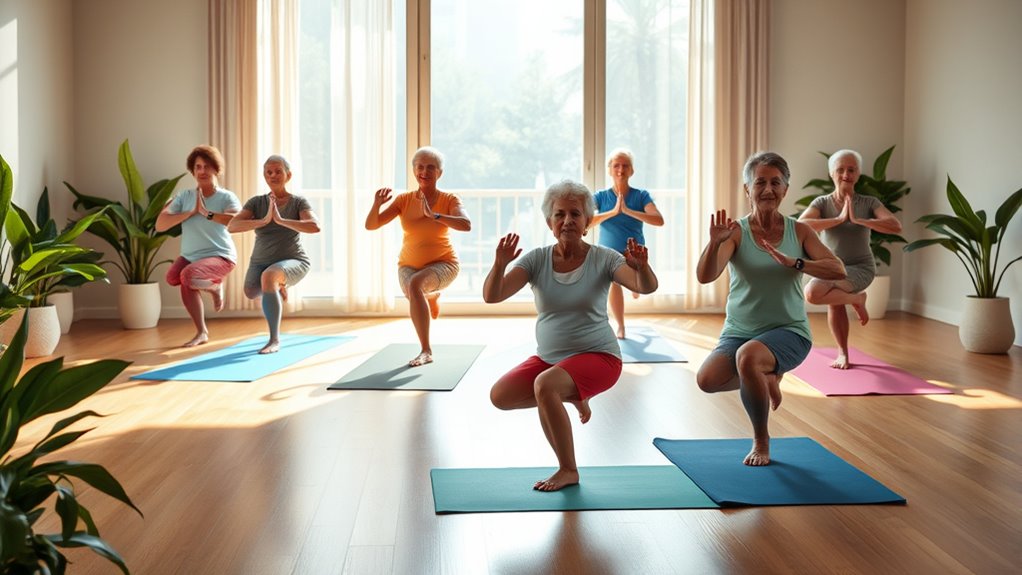
After enjoying the calming effects of restorative yoga, it’s time to shift focus to building lower body strength.
Strengthening your legs is essential for improving balance, stability, and mobility—key factors in preventing falls and injuries. Incorporate exercises like chair squats, seated leg lifts, and standing calf raises to target your quadriceps, hamstrings, and calves effectively.
Using light weights or resistance bands can enhance your muscle strength and endurance, contributing to better overall function. Aim to engage in lower body routines at least two to three times a week.
You’ll likely notice significant gains in strength and improvements in daily activities, such as climbing stairs and getting in and out of chairs, fostering greater independence.
Day 22: Fostering Community Connection
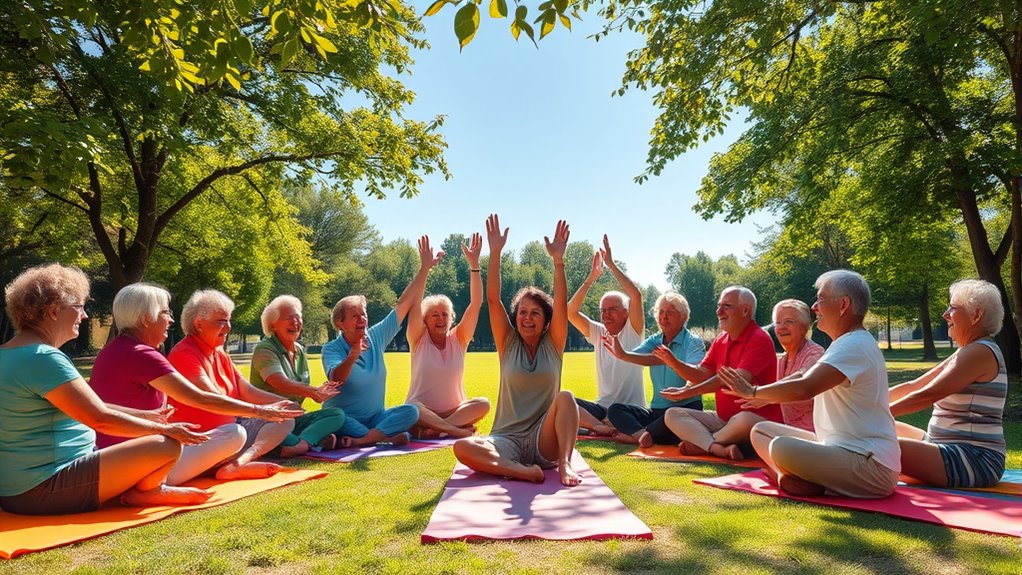
When you foster community connections, you not only enrich your own life but also contribute to the well-being of those around you. Engaging with others can greatly improve your mental health and reduce feelings of loneliness.
Consider joining group activities or events where you can:
- Share laughter and stories during yoga classes
- Participate in community center gatherings filled with warmth
- Volunteer your skills and experience to inspire others
- Build lasting friendships through shared interests and activities
These connections enhance your sense of belonging and promote a healthier lifestyle.
Research shows that seniors with strong social ties enjoy better physical health outcomes and increased mobility.
Day 23: Incorporating Props for Support
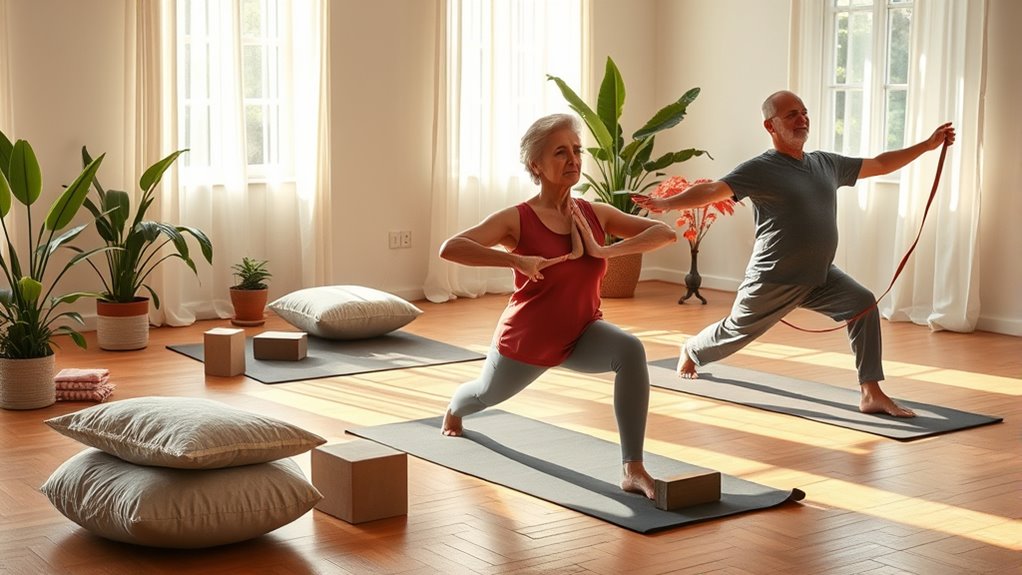
Incorporating props into your yoga practice can considerably enhance your experience, providing the support and stability you need to feel more confident in each pose.
Incorporating props into your yoga practice enhances support and stability, boosting your confidence in every pose.
Yoga blocks, straps, and bolsters make poses more accessible, especially for seniors. A chair can be a great ally, offering extra support for seated or standing poses while helping you maintain balance and a full range of motion.
Straps can assist you in achieving deeper stretches and ensuring proper alignment, which is especially helpful if you have limited flexibility.
Bolsters elevate your hips in seated poses or provide cushioning in restorative poses, promoting comfort and relaxation.
Props also allow you to modify poses, ensuring you practice safely without straining your body.
Day 24: Practicing Gratitude Through Yoga

Today, you’ll focus on practicing gratitude through yoga, which can greatly boost your emotional well-being.
By incorporating mindful breathing techniques and gratitude meditation, you’ll cultivate a positive mindset during your practice.
Reflective journaling after your session can help you capture and reinforce those feelings of thankfulness, enhancing your overall experience.
Mindful Breathing Techniques
Mindful breathing techniques can transform your yoga practice, especially when you focus on gratitude. By incorporating these techniques, you enhance relaxation and deepen your connection with the present moment.
Here’s how you can practice gratitude through mindful breathing:
- Inhale deeply through your nose, visualizing a warm light filling your body.
- Think of a person, place, or experience you’re grateful for as you breathe in.
- Exhale slowly through your mouth, releasing tension and negative thoughts.
- Feel each pose become richer, as gratitude amplifies your mind-body connection.
Engaging in this practice not only improves lung capacity but also fosters a positive outlook, making your yoga sessions more meaningful and enriching.
Embrace gratitude, and watch your practice flourish.
Gratitude Meditation Practice
Continuing your journey of mindful breathing, you can deepen your practice by embracing gratitude meditation in your yoga sessions.
As you flow through each pose, focus on cultivating a mindset of appreciation. Acknowledging the strength of your body and the peace of your mind enhances your physical and emotional well-being.
Incorporating gratitude into your practice not only improves your focus but also reduces stress, promoting mindfulness and positive thinking.
Research shows that expressing gratitude regularly boosts happiness and mental health, especially among seniors. Sharing intentions with fellow yogis fosters a sense of community and connection, enriching your experience.
Realizing the benefits of gratitude makes each session more meaningful, nurturing both your body and spirit.
Reflective Journaling Benefits
Reflective journaling offers a powerful way for seniors to connect with their yoga practice and cultivate gratitude. By putting pen to paper, you can articulate your thoughts and feelings, enhancing self-awareness and emotional well-being.
Practicing gratitude through journaling helps reduce stress and anxiety, promoting a positive mindset. Consider these benefits:
- Improved physical health, linked to better sleep and reduced illness symptoms
- A deeper connection between mind and body, making yoga more fulfilling
- Enhanced social interactions and relationships within a supportive community
- A daily routine that fosters resilience and emotional richness
Incorporating these practices into your life can transform your yoga journey, making each session more meaningful and rewarding.
Day 25: Celebrating Progress and Growth
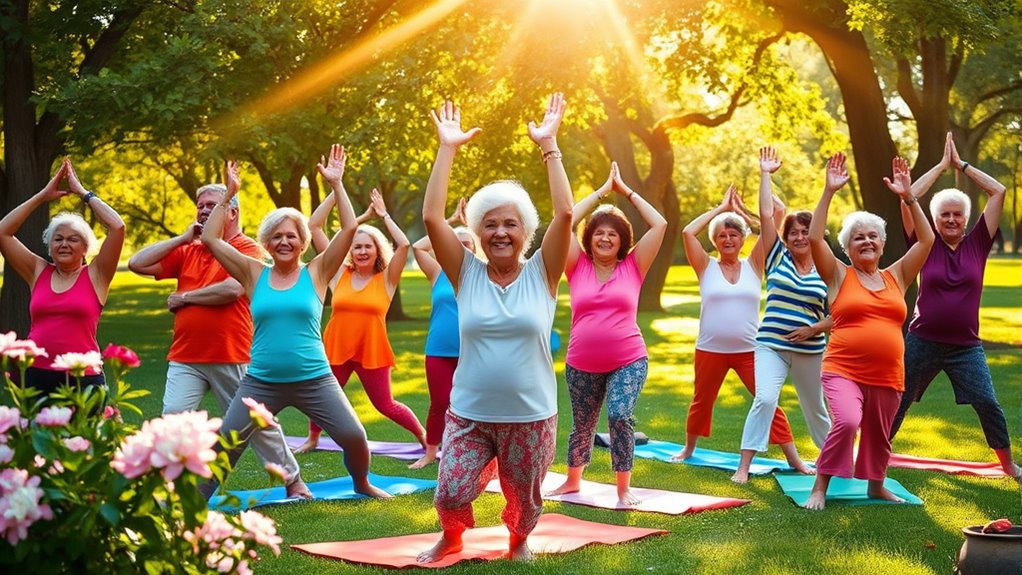
Celebration fills the air on Day 25 of your yoga journey, as you take a moment to acknowledge the strides you’ve made over the past month.
You’ve improved your flexibility, strength, and overall well-being, and it’s time to recognize those achievements. Maybe you’ve held poses longer or mastered new stretches—these small milestones boost your motivation and enrich your practice.
Consider the mental clarity and relaxation you’ve gained from your daily sessions; this positive shift contributes to a greater sense of accomplishment.
Join a group discussion or jot down your experiences in a journal—sharing fosters a supportive community and reinforces your progress.
Use this insight to tailor future practices, ensuring you continue on your path to health and fitness.
Day 26: Engaging in Mindful Eating

Today, you’re going to explore the importance of mindful eating and its benefits for your health.
By focusing on techniques like savoring each bite and minimizing distractions, you can enhance your mealtime experience.
Embracing this practice can lead to healthier food choices and greater satisfaction with your meals.
Importance of Mindful Eating
Have you ever noticed how quickly meals can disappear when you’re not fully present? Engaging in mindful eating can transform your dining experience, helping you savor every moment. By focusing on the taste, texture, and aroma of your food, you can enhance your enjoyment and satisfaction.
Consider these benefits:
- Heightened awareness of hunger and fullness cues, reducing overeating.
- Improved dietary choices as you become more conscious of what you eat.
- Alleviation of emotional eating by recognizing triggers for your habits.
- Enhanced digestion through slow chewing and savoring each bite.
Incorporating mindful eating into your routine can contribute to weight management and overall health, making it an essential practice for a balanced lifestyle.
Techniques for Mindful Eating
How can you truly savor your meals and foster a healthier relationship with food? Start by practicing mindful eating. Pay full attention to the colors, textures, flavors, and smells of your food. Chew slowly and savor each bite; this enhances your sensory experience and satisfaction.
Create a dedicated eating space free from distractions like phones and TV. Before you eat, take a moment to express gratitude for your meal. This simple act can shift your mindset and encourage a deeper connection with your food.
Benefits for Seniors’ Health
While many seniors may overlook the importance of mindful eating, engaging in this practice can greatly enhance your health and well-being. By paying attention to your hunger cues and fullness signals, you can create a healthier relationship with food.
Here are some benefits you may experience:
- Improved digestion and enhanced enjoyment of meals
- Reduced stress and anxiety surrounding eating
- Better weight management and nutrition
- Strengthened social connections during meals
Mindful eating encourages you to savor each bite, fostering a positive atmosphere around dining.
As you cultivate this awareness, you’ll not only nourish your body but also uplift your mental health, making every meal an opportunity for joy and connection.
Embrace mindful eating for a healthier life!
Day 27: Integrating Yoga Into Daily Life
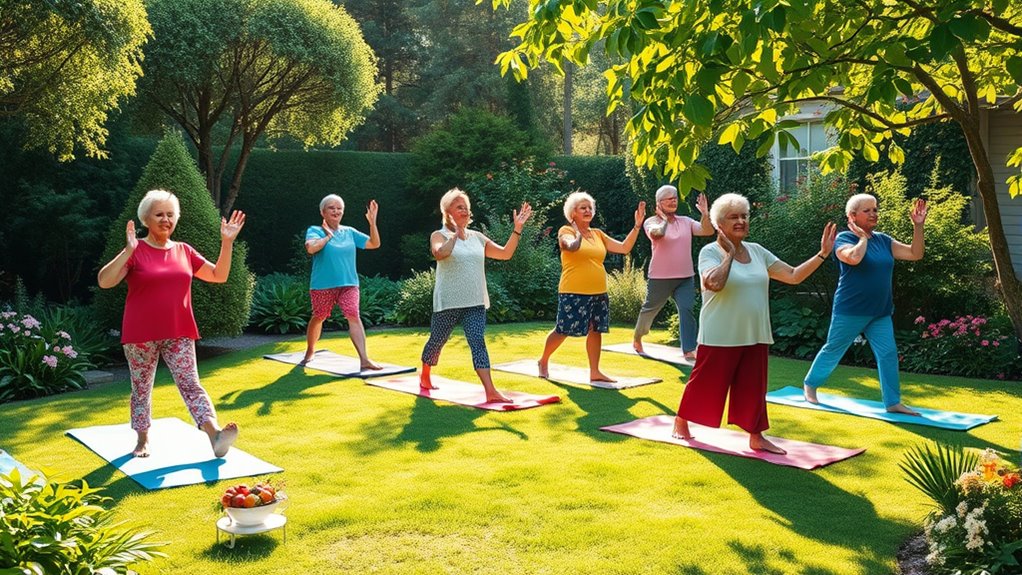
As you embrace the journey of integrating yoga into your daily life, you’ll discover numerous ways to enhance your physical health and mental well-being.
Simple yoga stretches and poses, like Mountain Pose or seated stretches, can easily fit into your routine while watching television or reading. Commit to just 10-15 minutes each day; this consistency can greatly improve your mobility and reduce stress over time.
Focus on your breath during these practices to boost mental clarity and promote relaxation in everyday activities.
Additionally, consider joining a supportive community, whether in-person or online, to help keep you motivated and dedicated to your yoga journey.
Integrating these practices can transform your lifestyle and lead to a healthier, happier you.
Day 28: Reflecting on the Journey

Reflecting on your 28-day yoga journey reveals the incredible progress you’ve made. You’ve not only embraced physical changes but also nurtured your mental well-being.
Take a moment to celebrate these milestones:
- Increased flexibility, allowing you to move with greater ease
- Enhanced balance, boosting your confidence in daily activities
- Improved breath control, helping you manage stress effectively
- A supportive community, sharing experiences and challenges along the way
These achievements highlight the holistic benefits of your commitment.
As you track your progress, remember the clarity and calmness yoga has brought into your life. This journey doesn’t end here; it’s just the beginning.
Continue to weave yoga into your daily routine, and enjoy the ongoing benefits for your body and mind.
Frequently Asked Questions
What Happens if You Do Yoga Everyday for a Month?
If you do yoga every day for a month, you’ll likely notice significant improvements in your flexibility, strength, and balance.
Your coordination may enhance, reducing the risk of falls. You might feel less stressed and anxious, as daily practice helps lower cortisol levels and boosts your mood.
Plus, you’ll probably experience better respiratory function and increased lung capacity, leading to improved endurance.
Should Seniors Do Yoga Every Day?
Yes, seniors should consider practicing yoga every day.
Daily sessions can enhance your flexibility, strength, and balance, which helps reduce the risk of falls.
You’ll also experience relief from chronic pain and improved mental well-being through relaxation.
Consistent practice promotes better sleep and supports your respiratory and cardiovascular health.
Just remember to listen to your body, starting with gentle routines and gradually increasing the intensity to guarantee a safe and beneficial experience.
Will 20 Minutes of Yoga a Day Make a Difference?
They say, “A journey of a thousand miles begins with a single step.”
Committing to just 20 minutes of yoga each day can indeed make a significant difference in your life. You’ll notice improved flexibility, muscle strength, and balance, which are essential for maintaining your independence.
Additionally, daily practice can enhance your mental health, alleviate chronic pain, and even boost your sleep quality.
Embrace this small daily commitment, and watch the positive changes unfold.
What Is the Best Type of Yoga for Seniors?
The best type of yoga for you as a senior often includes gentle styles like Hatha or Restorative.
These focus on slow movements and deep breathing, promoting relaxation and flexibility.
If mobility’s a concern, chair yoga‘s a great choice, allowing you to practice safely.
Incorporating props can also enhance your experience by ensuring proper alignment.
Conclusion
As you roll up your yoga mat, think of it as a seed you’ve planted in the garden of your health. Each pose has nurtured your body and spirit, helping you grow stronger and more balanced. You’ve cultivated mindfulness, flexibility, and resilience, transforming your journey into a blossoming flower. Remember, this month is just the beginning—carry these lessons into your daily life, allowing your newfound strength to flourish and enrich every moment ahead.

